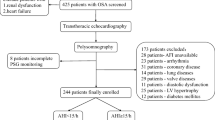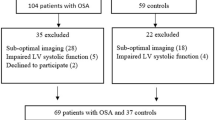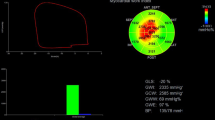Abstract
Background
Early identification of abnormal left ventricular function in children with obstructive sleep apnea (OSA) is difficult using conventional echocardiographic indices and commonly used clinical markers of myocardial damage. We sought to investigate the value of automatic function imaging and myocardial work parameters in predicting early cardiac impairment in children having OSA with preserved left heart function and thereby identifying an optimal index for assessment.
Patients and Methods
Fifty-two children who presented with symptoms of nocturnal sleep snoring and open-mouth breathing and 34 healthy controls were enrolled in this study. Clinical characteristics and conventional echocardiographic data were collected, and image analysis was performed using two-dimensional speckle-tracking echocardiography to obtain left ventricular global longitudinal strain (GLS), post-systolic index, peak strain dispersion, global work index (GWI), global constructive work (GCW), global wasted work, and global work efficiency.
Results
Children with OSA had significantly lower GLS, GWI, and GCW than those without (P < 0.05). Additionally, GWI (β = −32.87, 95% CI: −53.47 to −12.27), and GCW (β = −35.09, 95% CI: −55.35 to −14.84) were found to correlate with the disease severity in the multiple linear regression mode, with worsening values observed as the severity of the disease increased. ROC curve analysis revealed that GCW was the best predictor of myocardial dysfunction, with an AUC of 0.809 (P < 0.001), and the best cutoff point for diagnosing myocardial damage in children with OSA was 1965.5 mmHg%, with a sensitivity of 92.5% and a specificity of 58.7%.
Conclusions
GLS, GWI, and GCW were identified as predictors of myocardial dysfunction in children with OSA, with GCW being the best predictor.



Similar content being viewed by others
Availability of data and materials
All of the material is owned by the authors and/or no permissions are required.
References
Lumeng JC, Chervin RD (2008) Epidemiology of pediatric obstructive sleep apnea. Proc Am Thorac Soc 5(2):242–252
Marcus CL, Brooks LJ, Draper KA et al (2012) Diagnosis and management of childhood obstructive sleep apnea syndrome. Pediatrics 130(3):e714-755
Pettitt-Schieber B, Tey CS, Hill R et al (2021) The utility of preoperative echocardiography in pediatric obstructive sleep apnea. Sleep & Breathing = Schlaf & Atmung 25(4):2171–2178.
Pettitt-Schieber B, Tey CS, Nemeth J et al (2021) Echocardiographic findings in children with obstructive sleep apnea: a systematic review. Int J Pediatr Otorhinolaryngol 145:110721
Bitners AC, Arens R, Mahgerefteh J et al (2021) Prevalence of elevated right ventricular pressure in children with obstructive sleep apnea syndrome undergoing pulmonary hypertension screening. J Clin Sleep Med 17(11):2225–2232
Kim DY, Ko KO, Lim JW et al (2018) The improvement of right ventricular function after adenotonsillectomy in children with obstructive sleep apnea. Korean J Pediatr 61(12):392–396
Domany KA, Huang G, Hossain MM et al (2021) Effect of adenotonsillectomy on cardiac function in children age 5–13 years with obstructive sleep apnea. Am J Cardiol 141:120–126
Weber SA, Pierri Carvalho R, Ridley G et al (2014) A systematic review and meta-analysis of cohort studies of echocardiographic findings in OSA children after adenotonsilectomy. Int J Pediatr Otorhinolaryngol 78(10):1571–1578
Cameli M, Mandoli GE, Sciaccaluga C et al (2019) More than 10 years of speckle tracking echocardiography: still a novel technique or a definite tool for clinical practice? Echocardiography (Mount Kisco, NY) 36(5):958–970
Mandoli GE, Borrelli C, Cameli M et al (2022) Speckle tracking echocardiography in heart failure development and progression in patients with apneas. Heart Fail Rev 27(5):1869–1881
Chan J, Edwards NFA, Scalia GM et al (2020) Myocardial work: a new type of strain imaging? J Am Soc Echocardiogr 33(10):1209–1211
Edwards NFA, Scalia GM, Shiino K et al (2019) Global myocardial work is superior to global longitudinal strain to predict significant coronary artery disease in patients with normal left ventricular function and wall motion. J Am Soc Echocardiogr 32(8):947–957
Przewlocka-Kosmala M, Marwick TH, Mysiak A et al (2019) Usefulness of myocardial work measurement in the assessment of left ventricular systolic reserve response to spironolactone in heart failure with preserved ejection fraction. Eur Heart J Cardiovasc Imaging 20(10):1138–1146
Ni X (2020) Guidelines for the diagnosis and treatment of obstructive sleep apnea in children in China (2020). Chin J Evid Based Med 20(08):883–900
Sluysmans T, Colan SD (2005) Theoretical and empirical derivation of cardiovascular allometric relationships in children. J Appl Physiol (Bethesda, Md: 1985) 99(2):445–457
Manganaro R, Marchetta S, Dulgheru R et al (2019) Echocardiographic reference ranges for normal non-invasive myocardial work indices: results from the EACVI NORRE study. Eur Heart J Cardiovasc Imaging 20(5):582–590
Li F, Ji CY, Zong XN et al (2009) Growth curves of body mass index in Chinese children and adolescents aged 0 to 18 years. Chinese J Pediatr 07:493–498
Dallaire F, Slorach C, Bradley T et al (2016) Pediatric reference values and Z score equations for left ventricular systolic strain measured by two-dimensional speckle-tracking echocardiography. J Am Soc Echocardiogr 29(8):786-793.e788
Bian XM, Han GH, Liu Y et al (2019) Research progress on the correlation between obstructive sleep apnea hypoventilation syndrome and multisystem diseases in children. Chinese Otolaryngol Head Neck Surg 26(06):325–328
Teplitzky TB, Pereira KD, Isaiah A (2019) Echocardiographic screening in children with very severe obstructive sleep apnea. Int J Pediatr Otorhinolaryngol 126:109626
Lavie L (2015) Oxidative stress in obstructive sleep apnea and intermittent hypoxia–revisited–the bad ugly and good: implications to the heart and brain. Sleep Med Rev 20:27–45
Deng M (2018) Correlation of OSAHS-mediated intermittent hypoxemia with left ventricular hypertrophy. Nanchang University, Master
Park DH, Shin CJ, Hong SC et al (2008) Correlation between the severity of obstructive sleep apnea and heart rate variability indices. J Korean Med Sci 23(2):226–231
Ng AC, Davis GM, Chow CM et al (2010) Impact of sleep disordered breathing severity on hemodynamics, autonomic balance and cardiopulmonary functional status in chronic heart failure. Int J Cardiol 141(3):227–235
Davidovski FS, Goetze JP (2019) ProANP and proBNP in plasma as biomarkers of heart failure. Biomark Med 13(13):1129–1135
Xu L, Keenan BT, Maislin D et al (2021) Effect of obstructive sleep apnea and positive airway pressure therapy on cardiac remodeling as assessed by cardiac biomarker and magnetic resonance imaging in Nonobese and obese adults. Hypertension (Dallas, Tex : 1979) 77(3):980–992
Ismail K, Roberts K, Manning P et al (2015) OSA and pulmonary hypertension: time for a new look. Chest 147(3):847–861
Shi F, Feng S, Zhu J et al (2018) Left ventricular strain and Dyssynchrony in young and middle-aged peritoneal dialysis patients and healthy controls: a case-matched study. Cardiorenal medicine 8(4):271–284
Aagaard EN, Kvisvik B, Pervez MO et al (2020) Left ventricular mechanical dispersion in a general population: data from the Akershus Cardiac Examination 1950 study. Eur Heart J Cardiovasc Imaging 21(2):183–190
Asanuma T, Nakatani S (2015) Myocardial ischaemia and post-systolic shortening. Heart (Br Cardiac Soc) 101(7):509–516
Rumbinaite E, Karuzas A, Verikas D et al (2020) Detection of functionally significant coronary artery disease: role of regional post systolic shortening. J Cardiovasc Echogr 30(3):131–139
Voigt JU, Lindenmeier G, Exner B et al (2003) Incidence and characteristics of segmental postsystolic longitudinal shortening in normal, acutely ischemic, and scarred myocardium. J Am Soc Echocardiogr 16(5):415–423
Galli E, Leclercq C, Fournet M et al (2018) Value of myocardial work estimation in the prediction of response to cardiac resynchronization therapy. J Am Soc Echocardiogr 31(2):220–230
Bisbal F, Baranchuk A, Braunwald E et al (2020) Atrial failure as a clinical entity: JACC review topic of the week. J Am Coll Cardiol 75(2):222–232
Wu CJ, Chen MX, Hu QD et al (2021) Progress in the study of intracardiac hemorrhage in patients with acute myocardial infarction after coronary intervention. Chinese J Cardiovasc Dis 49(03):293–297
Acknowledgements
We thank Medjaden Inc. for scientific editing of this manuscript.
Authors’ contributions
Juncheng Ni and Fan Zhang are equal contributors.
Funding
Not applicable.
Author information
Authors and Affiliations
Contributions
QQX, as the corresponding author, was the chief investigator. JCN, FZ, WQX, XLH, XYZ, YWS, LC, YQW and JH were co-investigators. JCN, WQX, XLH, YWS and LC collected and managed ultrasonography data. FZ, XYZ, YQW and JH collected and analyzed clinical data. JCN drafted the manuscript. WQX participated in data interpretation and manuscript drafting. All authors read and approved the final manuscript. JCN and FZ equally contribute to this study as first co-authors.
Corresponding author
Ethics declarations
Ethical Approval
The study protocol was approved by the medical ethics committee of the Children’s Hospital of Soochow University (approval number: 2021CS134). The guardians of all the enrolled children signed an informed consent form upon admission.
Competing interests
The authors have no competing interests as defined by BMC, or other interests that might be perceived to influence the results and/or discussion reported in this paper.
Consent for publication
Not Applicable.
Additional information
Publisher's Note
Springer Nature remains neutral with regard to jurisdictional claims in published maps and institutional affiliations.
Rights and permissions
Springer Nature or its licensor (e.g. a society or other partner) holds exclusive rights to this article under a publishing agreement with the author(s) or other rightsholder(s); author self-archiving of the accepted manuscript version of this article is solely governed by the terms of such publishing agreement and applicable law.
About this article
Cite this article
Ni, JC., Zhang, F., Xu, WQ. et al. Role of automated functional imaging and myocardial work in assessment of cardiac function in children with obstructive sleep apnea. Int J Cardiovasc Imaging 40, 601–611 (2024). https://doi.org/10.1007/s10554-023-03030-6
Received:
Accepted:
Published:
Issue Date:
DOI: https://doi.org/10.1007/s10554-023-03030-6




